MARIANI’S
March
20,
2011
NEWSLETTER
Click Here
to return to John Mariani's Hompage
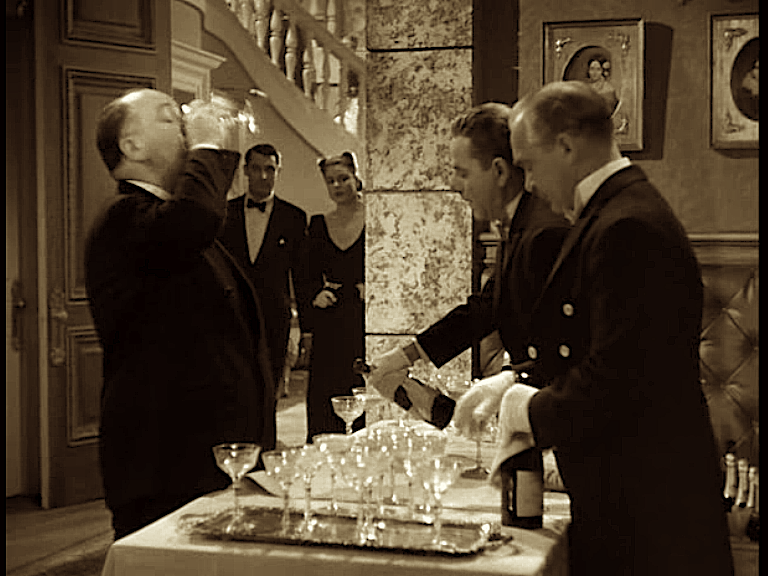
Alfred
Hitchcock, Gary Grant and Ingrid Bergman in "Notorious" (1946)
This Week
Wandering Wales, Part One
by John Mariani
New York Corner: Ai Fiori
by John Mariani
Vegas and NASCAR and The Best Tailgate BBQ Ever
by Christopher Mariani
Now That St. Patrick's Day Is Over, Don't Waste Expensive Irish Whiskeys in Irish Coffee
by John Mariani
❖❖❖
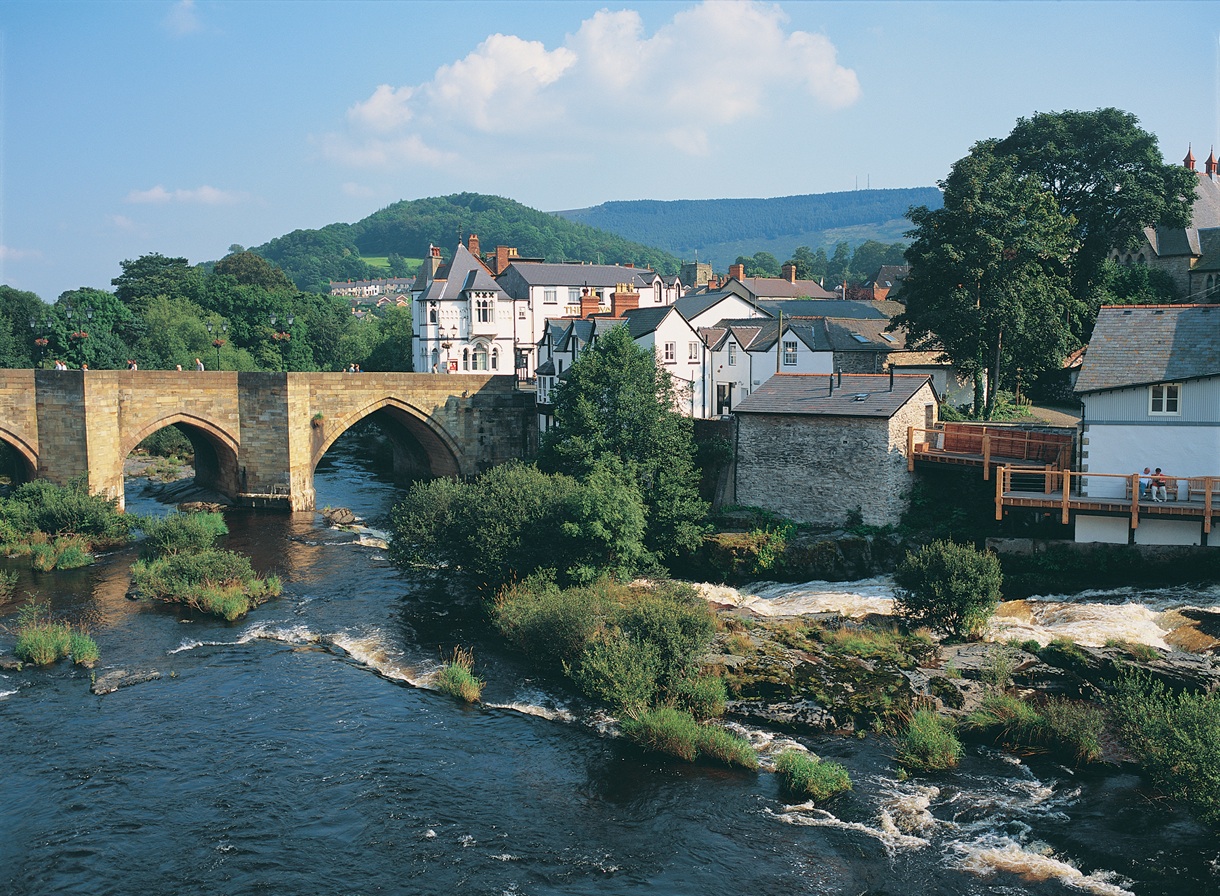
"My birthday began with the water -
Birds and the birds of the winged trees flying my name
Above the farms and the white horses
And I rose
In rainy autumn
And walked abroad in a shower of all my days"
--Dylan Thomas, 'Poem in October' (1946)
Except for my own birthday being in August, these lines by Wales' greatest poet describe perfectly the days I spent in Wales last fall, beneath gray, rainy skies above rolling and flat farmlands, hill towns and seaside cities. Still, the bucolic beauty of even an inclement Wales was enough to make me want to return right now, in springtime, when its fields burst forth in flowers and greenery, when, as Thomas (right) wrote in another poem that year, "Fern Hill," he felt "young and easy under the apple
 boughs/About the lilting house and happy as the grass."
boughs/About the lilting house and happy as the grass."Not least of Wales' charms is its seeming remoteness, not so much by geography (you can be there in about three hours by train from London) but by its indigenous and independent spirit. Wales, like Scotland and Ireland, had its rough times with England over centuries, and the region is still fairly bilingual, with about 22 percent of its three million people speaking their native tongue, and
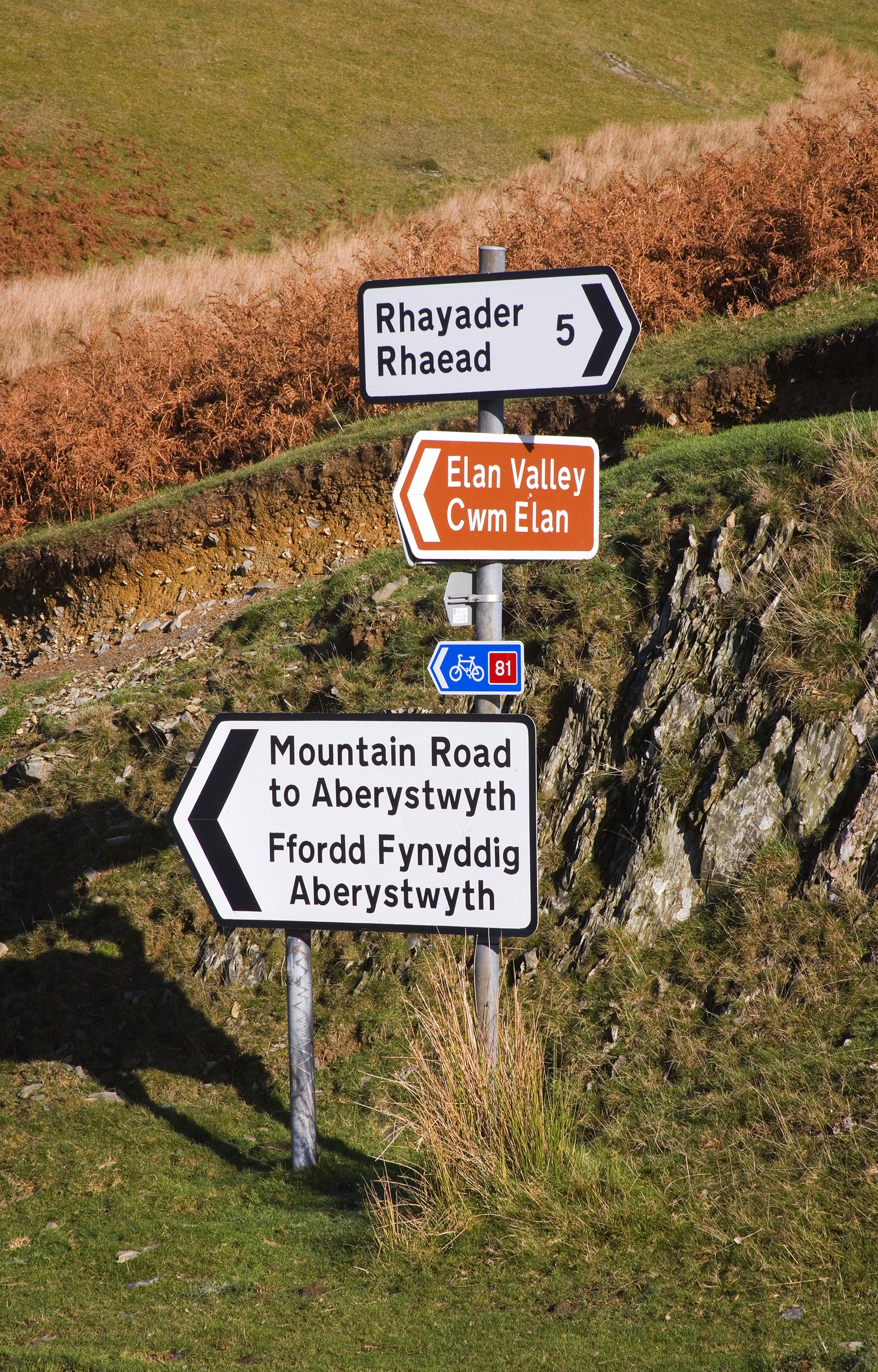 street and business signs
throughout the country are in Welsh, a Celtic language with long
inscrutable words full of double consonants and northern and southern
dialects, so that in the north, the question "Do you want a cup of
tea" is "Dach chi isio panad?"
while in the south it's "Ych
chi'n
moyn dishgled?" Fortunately, everybody speaks English as
well. And I found everyone I met extremely cordial to a visiting
Yank.
street and business signs
throughout the country are in Welsh, a Celtic language with long
inscrutable words full of double consonants and northern and southern
dialects, so that in the north, the question "Do you want a cup of
tea" is "Dach chi isio panad?"
while in the south it's "Ych
chi'n
moyn dishgled?" Fortunately, everybody speaks English as
well. And I found everyone I met extremely cordial to a visiting
Yank.SOME QUICK FACTS ABOUT WALES
● Wales is about the size of Massachusetts.
● There are four sheep for every person in the country.
● Wales has 641 castles.
● The annual World Bog Snorkeling Championships are held in late August.
● The city of Porthcawl holds an Elvis Festival each year.
● More of Wales is inside the boundary of a National Park than any other part of the UK.
● Parts of the films "Robin Hood" (2010), "Harry Potter and the Deathly Hallows" (2010), "Die Another Day" (2002), "Lara Croft Tomb Raider" (2003), and "Lawrence of Arabia" (1962) were shot in Wales.
● St. David is Wales' patron saint.
● Richard Burton, Tom Jones, Glynis Johns, Ray Milland, Catherine Zeta-Jones, Augustus John, Laura Ashley, Mary Quant, T.E. Lawrence, Shirley Bassey, Spencer Davis, Bertrand Russell, and Ken Follett were all born in Wales.
● For complete info on Wales go to www.usa.visitwales.com.
I began my trip by taking the train from London to Swansea on the southwest coast, Dylan Thomas's
 home, which he called an "ugly, lovely town,"
which is
not entirely inapt, although he would be rightly proud of the superb Dylan
Thomas Centre (right)
opened in his honor, with videos, recordings, first editions, and
letters all beautifully displayed in a fine yellow building. The town
was once a Viking outpost and
during the Industrial Revolution was so famous for its copper smelting
that it was dubbed "Copperopolis," though the decline of that industry
led to a period of debilitation, not helped by German Blitz bombings in
World War II that pretty much leveled the city, though the Cathedral
survived.
home, which he called an "ugly, lovely town,"
which is
not entirely inapt, although he would be rightly proud of the superb Dylan
Thomas Centre (right)
opened in his honor, with videos, recordings, first editions, and
letters all beautifully displayed in a fine yellow building. The town
was once a Viking outpost and
during the Industrial Revolution was so famous for its copper smelting
that it was dubbed "Copperopolis," though the decline of that industry
led to a period of debilitation, not helped by German Blitz bombings in
World War II that pretty much leveled the city, though the Cathedral
survived.Surrounded by uplands and farms, Swansea is indeed a city on the sea, its maritime history stretching back to prehistoric times, and the Marina is now a thriving residential area. Oxford Street is the main commercial conduit in city center, whose old, sometimes shabby buildings are a trove of art deco façades. The city's cultural attractions include the Glynn Vivian Art Gallery, the Swansea Museum, the National Waterfront Museum, and the Grand Theatre, a Victorian beauty now in its 144th year. In summer, outdoor Shakespeare performances are given at Oystermouth Castle. Pubs abound, as they do throughout Wales. There is also a sprawling food and merchandise market where you can get your first taste of a variety of meat-filled tarts in very flaky pastry, which makes for a hearty lunch all on its own.
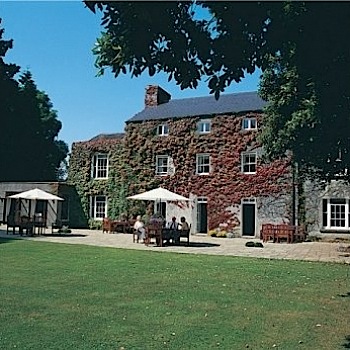 After
hiring
a
car
and
anxiously
maneuvering
onto
the
left-hand
side
of the road--we snapped off one rear view mirror
within ten minutes--we drove out of town and settled into a
darling 18th century inn with the Peter Pan-like name of Fairy Hill (left), set on 24
acres of parkland in nearby Gower. With its fireplaces (very welcome in
autumn), eight cozy rooms, and an excellent restaurant (which I shall
be reporting on next week about the food of Wales), the inn seems quite
removed from the 21st century, a virtue that may in fact be cherished
by some
guests, but for others like myself, the TV and Wi-Fi were very good to
have available.
After
hiring
a
car
and
anxiously
maneuvering
onto
the
left-hand
side
of the road--we snapped off one rear view mirror
within ten minutes--we drove out of town and settled into a
darling 18th century inn with the Peter Pan-like name of Fairy Hill (left), set on 24
acres of parkland in nearby Gower. With its fireplaces (very welcome in
autumn), eight cozy rooms, and an excellent restaurant (which I shall
be reporting on next week about the food of Wales), the inn seems quite
removed from the 21st century, a virtue that may in fact be cherished
by some
guests, but for others like myself, the TV and Wi-Fi were very good to
have available. The next day we took the M4 highway (a GPS is essential in navigating Wales) to the small village of Trapp, which also has a historic castle called Carreg Cennen set on a crag above the Brecon Beacons National Park, then across
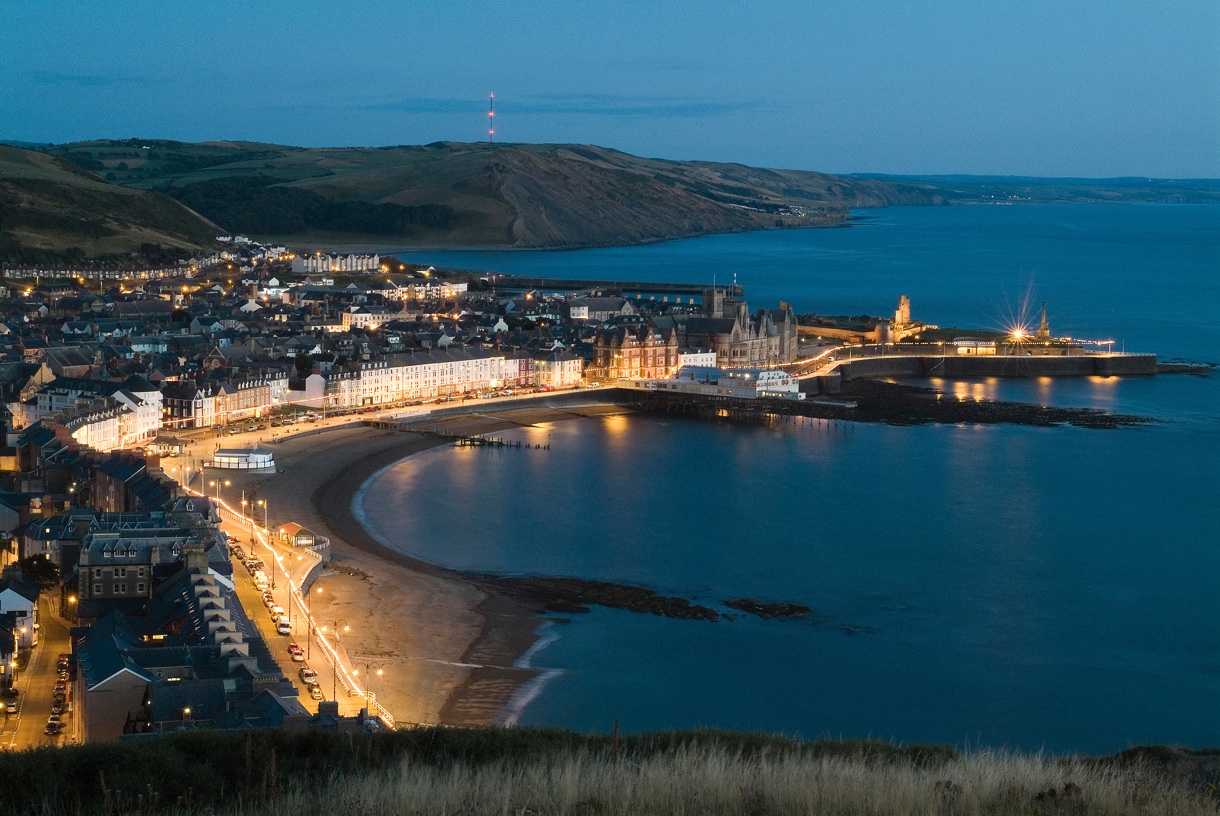 a
small stone bridge to
Llandeilo
in
the graceful Twyi Valley, whose river is the longest in Wales and whose
surroundings include the high moorlands, said to provide
excellent
hunting grounds. The town dates to Roman times, and the Britons built
the high-up Dynevor Castle. The town is
little more than a narrow main street but lined with small shops,
restaurants, and stores, all colorfully painted, all looking freshly
sprung
from 19th century stones in Carmarthenshire. So, too, the
town of Llandovery appears similarly frozen like some Welsh Brigadoon,
still with a weekend cattle market. Next was Aberaeron, home to the
Cardigan Bay Seafood Festival in July, and on to the great University
city of Aberyswith (right),
with its wide arc of seaside barriers and stately
houses looking out on the windswept coast of Cardigan.
a
small stone bridge to
Llandeilo
in
the graceful Twyi Valley, whose river is the longest in Wales and whose
surroundings include the high moorlands, said to provide
excellent
hunting grounds. The town dates to Roman times, and the Britons built
the high-up Dynevor Castle. The town is
little more than a narrow main street but lined with small shops,
restaurants, and stores, all colorfully painted, all looking freshly
sprung
from 19th century stones in Carmarthenshire. So, too, the
town of Llandovery appears similarly frozen like some Welsh Brigadoon,
still with a weekend cattle market. Next was Aberaeron, home to the
Cardigan Bay Seafood Festival in July, and on to the great University
city of Aberyswith (right),
with its wide arc of seaside barriers and stately
houses looking out on the windswept coast of Cardigan.When I was in graduate school years ago, I visited Aberyswith to do research for my dissertation on a Welsh poet named Walter Savage Landor, and back then I found its wild and rugged coastline thrilling, its fiery sunsets flashed with fleeting banks of clouds. It was good to come back and see the city little changed, its narrow streets curving in and around each other, its Victorian architecture sober but now colorfully painted, and the beautiful University on the hill, its research facilities far more modernized and digitalized than when I went there carrying pencil and notepad. Here, too, is the fine National Library of Wales and the Aberyswith Arts Centre.
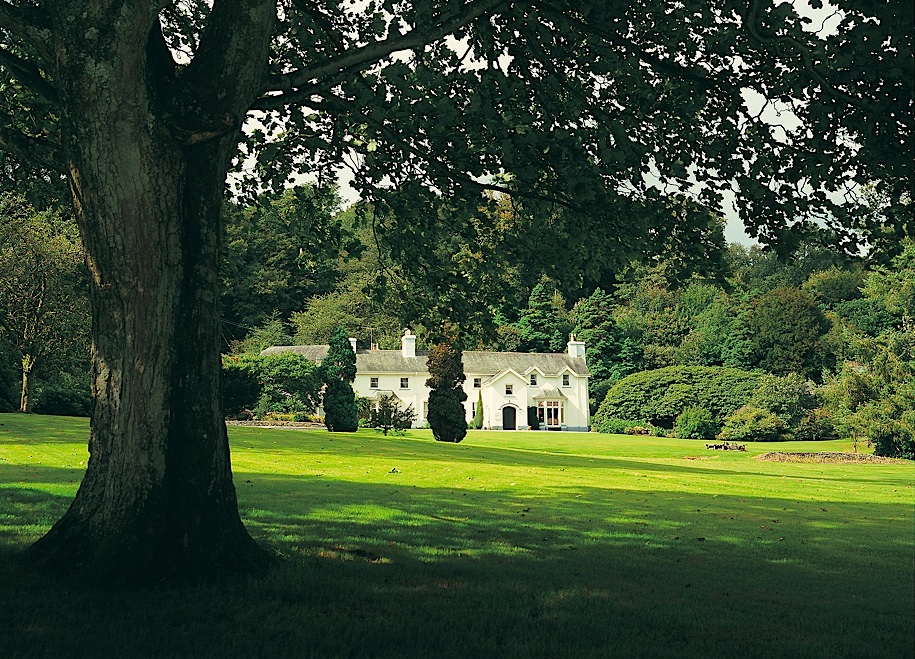 That night we stayed
at the oddly named Ynyshir Hall
(left) in Eglwysbach,
once owned by Queen Victoria (she may even have known she did), nestled
in leafy forest land off some of the most bewilderingly winding roads
in Wales on the
Dyfi Estuary, surrounded by low-lying mountains sung of in Welsh
folk ballads where demon lovers dwell and carry off their earthly
lovers. The clouds parted that evening,
and as promised in this luxury hotel's own brochures, the sky is so
dark
and far from city lights that the "Milky Way shines like a diamond
bracelet."
That night we stayed
at the oddly named Ynyshir Hall
(left) in Eglwysbach,
once owned by Queen Victoria (she may even have known she did), nestled
in leafy forest land off some of the most bewilderingly winding roads
in Wales on the
Dyfi Estuary, surrounded by low-lying mountains sung of in Welsh
folk ballads where demon lovers dwell and carry off their earthly
lovers. The clouds parted that evening,
and as promised in this luxury hotel's own brochures, the sky is so
dark
and far from city lights that the "Milky Way shines like a diamond
bracelet."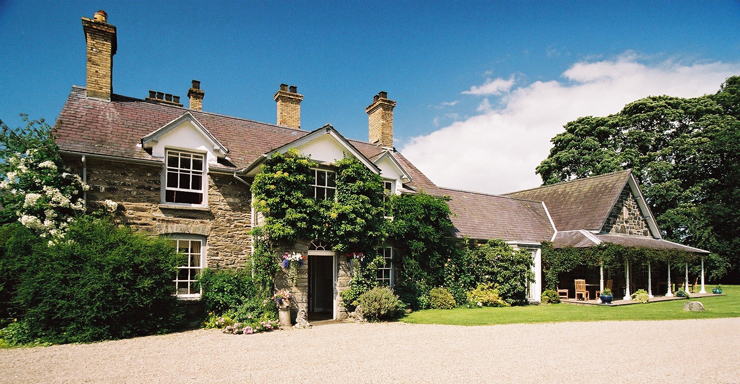
Our last night in Wales was spent at Tyddyn Llan (below) set on 14 acres at the tip of Snowdonia, where owner Bryan Webb , who calls his place a "Restaurant with Rooms," proudly boasts a Michelin star, with three grades of rooms including the Garden Suite, overlooking the tidy greens with their walls and gravel pathways. The rooms range in size from comfortably small to fairly commodious; the bathrooms can be chilly in the middle of an autumn night. But simply to breathe the night air, faint with sea salt, in complete, utter silence is to feel very close to the faraway spirit of Wales, faintly exotic and the lure to draw me back in sunnier, warmer days. We left the next morning and drove into the English city of Chester, whose own Georgian and Victorian architecture suggest entry into a town slightly more tilted towards the late 19th century. Wales seems still contentedly tied, even tongue-tied, to an earlier time, with an alluring patina of the antique and a sense of time out of time. As spring now begins to creeps over the moors and the forests and gardens begin to bud, it's time to go again.
NEW YORK CORNER
 AI FIORI
AI FIORI
Setai
Hotel
500 Fifth Avenue (near 36th Street)
212-613-8660
www.aifiorinyc.com
The
days
when
chef/owners
stayed
in
their
restaurants
cooking
every
night
are far from over--I would even say the high majority still do--but in
the era of the celebrity chef, the lure of big money, expansion, and
recognition have pulled many out of their kitchens and on to TV or food
festivals or faraway new venture, leaving their restaurants in the
hands of trained crews.
I am still very much of the mind that a restaurant
can be a very different place when the chef/owner is not around, and in
many instances, it shows immediately and with dire consequences.
But I also must admit that in a very
small number of cases, as with Jean-Georges Vongerichten, Daniel
Boulud, Mario Batali, and Alain Ducasse, the quality of food and
service at
restaurants within their mini-empires is very high. There is, of
course, no way of knowing how much better they might be if those chefs
were on premises every single night, but I would have no qualms
about dining at most of their restaurants even if those chefs
were off doing
whatever they do elsewhere.
Michael White (right)
seems
to
have
joined
this
prestigious
group,
now
owner
or partner in
Marea, Morini, and restaurants in New Jersey (he recently split from
partner Chris Cannon and the now closed restaurants Convivio and Alta),
with plans abroad. But his absences do not seem to have
measurably affected the service and quality of his restaurants.
One might argue that Marea, now almost two years old, can 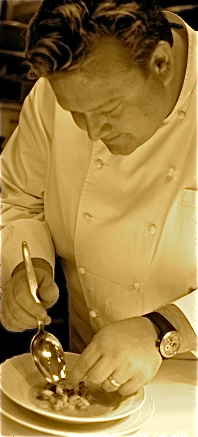 easily sail
on an even keel and that Morini, being a lusty Emilia-Romagnan
trattoria, rolls along with brio each night, but the proof of White's
apparent ability to hire the best people to man his kitchens and dining
rooms is evident in the impeccably run, very new Ai Fiori in the Fifth
Avenue Setai Hotel, which opened only weeks after Morini downtown.
easily sail
on an even keel and that Morini, being a lusty Emilia-Romagnan
trattoria, rolls along with brio each night, but the proof of White's
apparent ability to hire the best people to man his kitchens and dining
rooms is evident in the impeccably run, very new Ai Fiori in the Fifth
Avenue Setai Hotel, which opened only weeks after Morini downtown.
Ai Fiori's location, on the second floor is
not ideal (there's not much of a
view) and
some have carped the dining room has too much of a corporate hotel
look, with which I don't entirely disagree. But it is handsome,
at night a bit low lighted, and all the amenities of fine
dining--linens, china, stemware, flowers, and comfortable seating--are
in full flourish, and the waitstaff, plucked from some of NYC's best
restaurants, blends just the right amount of familiarity with
professionalism.
Chef
de
Cuisine
Chris
Jaeckle
conceives
and
plates
his
food
with just the right balance of
color,
flair and good taste, beginning with the appetizers of lustrous
line-caught
fluke, sea urchin, Ligurian lemon oil, and caviar. A
light
but very flavorful plate of blue crab,
creamy
avocado,
grapefruit,
a
touch
of
tarragon,
and
crispy
farinata
for texture is a delight,
and if you love sardines have them here with and tangy-sweet tomato
confit, and chickpea napoleon. "Mare e Monte" (surf and turf) is
a
lovely idea--scallops with celery root, black truffles, thyme and
luscious bone marrow.
The
foie
gras
"au naturel" comes with spiced
figs, an Ormeasco mostarda and
brioche
toast,
and
there's
more
foie
gras
in the form
of a croquette with
perfectly roasted breast of squab in a sauce of Madeira, with tender
quince. A
decadent choice is the slowly
poached
egg
with
lobster,
sweetbread,
and
"nuage
layon."
 At this point you may wonder if White and Jaeckle are
really cooking Italian food, but with food of this caliber and
modernity, it is
a point not much worth discussion. White's most strictly Italian
restaurant is
Morini, while Marea is a homage to the finest seafood restaurants along
the
Italian coastline, but with his own New York notions. Ai Fiori
may have
an Italian name, but is is very much an expression of White's American
ingenuity.
At this point you may wonder if White and Jaeckle are
really cooking Italian food, but with food of this caliber and
modernity, it is
a point not much worth discussion. White's most strictly Italian
restaurant is
Morini, while Marea is a homage to the finest seafood restaurants along
the
Italian coastline, but with his own New York notions. Ai Fiori
may have
an Italian name, but is is very much an expression of White's American
ingenuity.
There is a lot of Italian brio going on
in the
pasta section, though, starting with a
Ligurian
crustacean
ragoût
of
cuttlefish,
scallops,
and
spiced
breadcrumbs.
Tender
ravioli
are filled with ricotta and mascarpone with boschetto cheese and a
lovely red wine glaze, while rice incorporates snails, parsley,
Parmigiano,
garlic chips and cotecchino--a
bit
overblown,
and
the
snails
get
lost
among
stronger flavors. The most traditional pasta is the agnolotti with braised
veal, butternut squash, and a rich sauce of black truffles.
Gnochetti are saffron
tinged and scented, which plays off well with crab and a
delicate form of sea urchins.
The
seafood
and
meat
courses
are
properly
few
in
number,
and are more
Pan-Mediterranean in their  style: black
bass
alla plancha with
mussels, chorizo, piquillo
peppers and saffron is good, but butter
poached lobster (above)
with
a
root
vegetable fondant made with a sauce from Château
Chalon--one of the "yellow wines" of the Jura--is a
triumph. Not so Dover sole with salsify, beurre noisette, lemon,
and
parsley, which oddly enough needed more fat from the fish itself and
maybe even
more butter sauce.
style: black
bass
alla plancha with
mussels, chorizo, piquillo
peppers and saffron is good, but butter
poached lobster (above)
with
a
root
vegetable fondant made with a sauce from Château
Chalon--one of the "yellow wines" of the Jura--is a
triumph. Not so Dover sole with salsify, beurre noisette, lemon,
and
parsley, which oddly enough needed more fat from the fish itself and
maybe even
more butter sauce.
My favorite among the meat dishes was a perfectly
cooked
roasted guinea hen with tomato confit, Taggiasca olives, and
lemon-thyme jus. Braised beef
cheek
daube with pommes purée,
olives,
and
orange
zest
comes
definitively
from
the French side of the Riviera, while a rack of
lamb
en crêpinette with Swiss chard crochetta shouts Provence.
The
desserts,
across
the
board,
are
exquisitely
conceived,
generous
in
their components and enchantingly plated, like the chocolate
tartlet with grapefruit, anise, and hazelnut gelato, and a baba al rhum
with passion fruit coulis and cream of coconut.
The refinement and range of Ai Fiori's menu is an
indication
of White's very special and continually evolving talent for big favors
done
with finesse. The concerns about his whereabouts outside his
restaurants
are legitimate, but for the moment, his NYC restaurants are among the
very best
of their kind.

MAN ABOUT TOWN
by
Christopher Mariani
VEGAS and NASCAR and the BEST TAILGATE BBQ EVER

Just
last
week
it
was
back
out
to
Vegas
for
another
wild weekend. Besides dining around the Aria hotel, partying at a
number of cool clubs and taking a few chances at the roulette table,
the reason
for my visit to the majestic city in the desert was to attend the
annual
Kingsford University class of 2011, hosted by world champion pitmaster
Chris
Lilly. The event was held at the Las Vegas Motor Speedway. Each year Kingsford puts together different events to share
the latest grilling techniques and tailgate tips to contest winners,
'que lovers, and grilling enthusiasts.
After
meeting some of the Kingsford
team Friday night, along with three
contest
winners brought out to Vegas all expenses paid, it was off to the
racetrack bright and early Saturday morning for some good old-fashioned
American
tailgating. The speedway is a good 45 minutes from the city, placed
directly
next to the Las Vegas Nellis Air Force Base where F-16’s soared above
and cut
through the sky, showcasing breathtaking aerial
maneuvers and insane
raw power
as their impressive engines muffled the rumble of forty-three
750-horsepower stock cars
ripping up the pavement at 185 miles per hour.
Once at parking lot five, we
entered our private tailgate
section filled with white tents, multiple grills and the tantalizing
aroma of
barbequed beef, chicken and pork. It may have only been 10 AM, but I
was ready to start eating the
second I got there. Chris Lilly (right)
and
cast
were
manning
a
custom-made
grill
and
smoker
put
together
by the fine gentlemen from www.pitmaker.com,
Texas-based George Shore and Victor Howard (above). This was no ordinary Weber
grill,
this monster was as bad as they get, fit with car-size wheels for
transportation, two separate grills with over eight feet of cooking
space, a huge
smoker oven where our juicy beef brisket had been cooking for hours, a
prep
station, and a massive HD flat screen television that rose up from
behind one
of the grills. This green machine was releasing smoky clouds of beef
brisket,
entire racks of ribs and whole chickens basted with dry and wet rubs,
barbeque
sauce that molded to the skin, and sat in small trays of its own
mouth-watering jus.
All heat and fire was produced by the use of Kingsford coals, no gas
allowed
here!
Here
are
a
few
interesting
facts
about
Kingsford
coal
and
its
history
-In
the
1920's
Henry
Ford
learned
about
the
process
for
turning
wood scraps from the
production of
Model T's into charcoal briquets. He built a charcoal plant and
invented
Kingsford charcoal, a company formed when E.G. Kingsford, a
relative of Ford's, brokered the site selection for the new
manufacturing plant. Today, Kingsford remains by far the leading
manufacturer of
charcoal in the U.S.. Each year more than one million
scraps of wood scraps are converted into quality charcoal briquets each
year. With
the
use
of
more
wood
char
and
the
deeper
grooves
resulting in a lighter product, the new briquets also produce
less ash,
meaning less waste going to the landfill. The new formula uses 57 fewer
tons of
coal per day, or 10 percent less non-renewable resources per year.
The
day
started with a few meat carving demonstrations as we learned about the different
cuts
of beef, the best way to cook them, and some great grilling
techniques.
Around noon, the talk of barbeque had left me craving the taste of
meat, and
thankfully lunch was near. Our first bites of the day were succulent
mouthfuls
of roasted chicken topped with caramelized onions, grilled peppers,
tangy 'que
sauce and spicy salsa. There were also trays of grilled corn, bowls of
fresh
guacamole and homemade spicy pickles. With the sun shining and the food
in
abundance I was a very happy man. I don’t recall much conversation
during that
meal, just the sounds of pleasurable moans that came from the belly of
each
attendee.
After
lunch
we toured the maze-like parking lot of RV’s and tailgate setups, where
I witnessed
Christmas
trees
decorated
with
empty
Bud
Light
beer
cans,
lots
of
racer Jeff Gordon memorabilia and hoards of Nascar fans charging up for the long
weekend. That afternoon, executive chef of Snake River Farms, Alan
Turner,
cooked up some beautifully marbleized Wagyu beef as he began his
demonstration
with a hilarious Rodney Dangerfield impersonation. Next, we all watched
in
amazement as an entire pig was carved up from start to finish
separating every
cut of meat from the original carcass in a fast 45 minutes, although he
contends that, uninterrupted, he can do it much faster.
As
the
sun
began
to
set,
we
began
our
mixed
drink
competition,
judged on
flavor,
presentation, creativity and the use of the grill. Teams quickly
assimilated
and made use of every ingredient possible, with Four Roses bourbon as the
base of
every the drink. I will tell you, after tasting cocktails with ribs
sticking
out of them,
others
with
soggy
bacon
floating
around
the
glass
and
some
with
chicken wings, judges Chris Lilly and mixologist Josh Perry from
Oakland,
California’s Pican
restaurant deserve a lot of credit. I figured I
would take
it easy on the guys and create a simple hot toddy using bourbon as the
base, a
few tablespoons of maple syrup, a touch of apple cider vinegar and then
rim the
glass with sugar and cinnamon. I guess that’s why I won the award for
“most
creative cocktail.” I got a piece of paper as a prize.
That evening under the
moonlight we finally got a chance to try Chris Lilly’s savory beef
brisket that
had been cooking in its own juices for hours. Sweet ribs and crispy
chicken
wings hit the table, along with juicy grilled sausage and slices of
well-fatted
skirt steak. The feast went on for hours and the food kept coming. It
wasn’t
until around eight or nine PM that we all rolled back onto the bus and
took a
snooze before heading out for a long night in Vegas.
The
following
morning
was
an
early
one
as
we
shuffled
back
onto
the bus and headed
to the track. We toured the entire speedway and even made our way down
to the
pits where we had the opportunity to meet some of America’s best Nascar
drivers, including Jimmy Johnson, Kyle Busch, Jeff Gordon and
Kingsford’s own,
Bobby Labonte #47. That afternoon we sat upstairs in the Kingsford
suite and
watched as these unbelievably powerful cars roared around the track at
top
speeds of 190 miles per hour.
As the weekend wrapped up, I realized I was at one
of the best tailgate parties to ever take place. I mean, what else
could a meat lover ask for? I was out in the desert drinking
bourbon while barbecuing with one of the world's greatest pitmasters
at a NASCAR race, the absolute mecca for tailgate parties.
❖❖❖
by John Mariani
 A
new
book entitled 101 Whiskeys to Try Before You Die
by Ian Buxton should keep connoisseurs busy both drinking and
debating the
merits of this bibulous bucket list of worldwide whiskies. It’s a good
selection, but I’m disappointed that so few Irish whiskies made the
cut, at a
time when both sales of “Oy-rish” are soaring.
A
new
book entitled 101 Whiskeys to Try Before You Die
by Ian Buxton should keep connoisseurs busy both drinking and
debating the
merits of this bibulous bucket list of worldwide whiskies. It’s a good
selection, but I’m disappointed that so few Irish whiskies made the
cut, at a
time when both sales of “Oy-rish” are soaring.
Back in 1988 Irish Distillers, when Pernod
Ricard
bought it, was selling less than half a million cases a year. Last year
its
Jameson brand alone passed the three million case mark, with 22
percent
growth in the U.S. alone. Meanwhile Diageo, since acquiring the
Bushmills
Irish Whiskey Distillery in 2005 for £200 million, has invested
more than £6
million in the facilities and brand. A report by IWSR (International
Wine and
Spirits Research) forecasts to 2012 that it is the non-Scotch sector of
the
whiskey market is among the fastest growing. Ireland drinks up
about 6
million bottles of its whiskies a year, with France the next biggest
consumer.
Just three large distilleries--Midleton (owned by
Pernod-Ricard) in Cork, Bushmills in Antrim, and Cooley in Louth (the
only one
Irish owned)—produce nearly every bottle of Irish whiskey, via dozens
of
labels. The minuscule rest is made by Kilbeggan Distillery, re-opened
in 2007
and owned by Cooley. Each year all the brands compete mightily to
come up
with a “new” whiskey, which in fact may be from very old casks. Most
Irish
whiskies are made from a mix of malted and unmalted barley and other
grains.
But the stand-out new products are the single malts, made from only one
type of
malted grain, barley, distilled at one distillery, usually in pot
stills.
Cooley’s Coonemara
brand alone now makes four small batch
whiskies—a 12-Year, a Single Cask, a Cask Strength, and the heavily
peated Turf
Mor labels. Most of these small batch whiskies, like the romantically
named
Irish 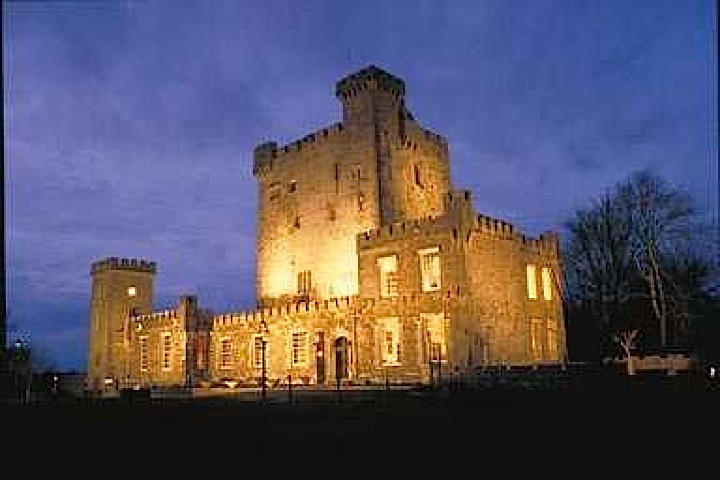 Tears,
never
leave
Ireland.
Some
are
even
sold
exclusively
at
The
Irish
Whiskey
Collection
at Dublin Airport, including a Midleton Single Cask
that
sells for £250. At these prices, they’re better sipped than as
the spike for
Irish coffee.
Tears,
never
leave
Ireland.
Some
are
even
sold
exclusively
at
The
Irish
Whiskey
Collection
at Dublin Airport, including a Midleton Single Cask
that
sells for £250. At these prices, they’re better sipped than as
the spike for
Irish coffee.
Yet as much as I’d like an excuse to go out and buy
all the
new Irish whiskies in the market, I can’t say enough new items comes
into the
U.S. market each year. One brand new release causing justified
excitement is a
16-year old Knappogue Castle "Twin
Wood"
single
malt
($100),
the
oldest
release
by
this
producer
so
far,
spending
15 years in old
bourbon casks,
followed by 9 months in oloroso sherry butts. With only 1,900 numbered
bottles
released so far—happily most of it goes to the U.S.--this may well be
the new
cult whiskey. It is a beautifully crafted whiskey, the malt and oak in
equal
measure to a sherry-like sweetness and a faint, lingering smoky burn at
the
end.
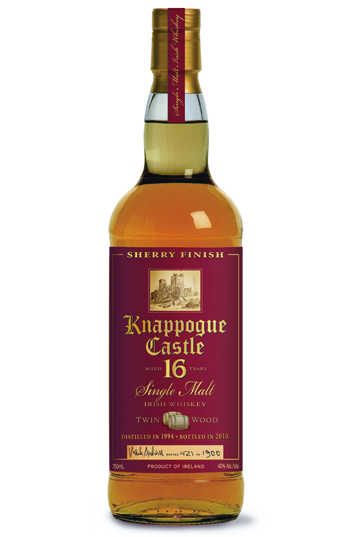 Knappogue
Castle (right) is also
offering a Master Distiller’s Private Selection 1994 vintage
($95) of 1,100 bottles. Vintage dating is still controversial in the
whiskey
world, since master blenders have traditionally drawn on many years’
whiskies
to come up with a consistent product. The spirits in this bottle
are from
various barrels, all from 1994. It is remarkably pale, a little
citrusy,
with barley and oak providing a subtle peaty and sweet balance.
Knappogue
Castle (right) is also
offering a Master Distiller’s Private Selection 1994 vintage
($95) of 1,100 bottles. Vintage dating is still controversial in the
whiskey
world, since master blenders have traditionally drawn on many years’
whiskies
to come up with a consistent product. The spirits in this bottle
are from
various barrels, all from 1994. It is remarkably pale, a little
citrusy,
with barley and oak providing a subtle peaty and sweet balance.
With Midleton
Very Rare ($125), bottled in 2010, you’re paying a bit for the
package—the
pretty oak wood box it comes in—but this whiskey, from John Jameson
&
Son’s, is labeled their “Supreme Selection,” the bottle numbered, with
a
printed signature of the master distiller, Barry Crockett.  Only
50
cases
are
made
each
year.
It’s
a
gorgeous
pure
gold
color
with
a burry nose, a
little
hotter than I would have thought, with a piney-vanilla aroma and
complex sweet
flavors that ends with a long finish and takes a splash of water well.
Only
50
cases
are
made
each
year.
It’s
a
gorgeous
pure
gold
color
with
a burry nose, a
little
hotter than I would have thought, with a piney-vanilla aroma and
complex sweet
flavors that ends with a long finish and takes a splash of water well.
Redbreast Pure Pot Still Irish Whiskey ($40), another of Pernod Ricard’s Irish Distillers’ brands, aged 12 years, has a niche following as an ideal expression of small batch Irish whiskey, claiming to be the “only 100% pure pot still” example on the market today. The label also says it’s “triple distilled,” but then, so are all Irish whiskies. It has strong pepper in the nose, hints of nutmeg and cinnamon, with a lush caramel undertone and fine long finish. It’s quite a buy at just $40. There is also a newly released 15 year old ($65-$85) in very limited supply.
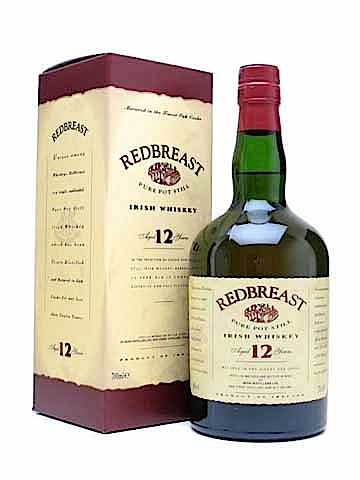 The
label of the tiny distillery of Kilbeggan,
which
the
label
dates
back
to
1757,
though
it
neglects
to
mention
that
the distillery stopped production in 1954 and closed down in 1957.
It only
started up again in 2007, and won’t be releasing its own bottlings
until
2014. The Kilbeggan now found in the market ($20) is actually
made by the
Cooley Distillery and transported to Kilbeggan for storage. It is
very,
very pale, with a pronounced sweetness and old-fashioned burn that
makes this a
good starter Irish whiskey, at least until the distillery releases its
own
three years from now.
The
label of the tiny distillery of Kilbeggan,
which
the
label
dates
back
to
1757,
though
it
neglects
to
mention
that
the distillery stopped production in 1954 and closed down in 1957.
It only
started up again in 2007, and won’t be releasing its own bottlings
until
2014. The Kilbeggan now found in the market ($20) is actually
made by the
Cooley Distillery and transported to Kilbeggan for storage. It is
very,
very pale, with a pronounced sweetness and old-fashioned burn that
makes this a
good starter Irish whiskey, at least until the distillery releases its
own
three years from now.
John Mariani's wine column appears in Bloomberg Muse News, from which this story was adapted. Bloomberg News covers Culture from art, books, and theater to wine, travel, and food on a daily basis.

FURTHER SIGNS OF THE DECLINE
OF AMERICAN INSTITUTIONS, #4,566
In Savannah,
GA, Girl Scouts are
no longer able to sell their famous cookies outside the home
of the woman who founded the organization almost a century ago, Juliette
Gordon Low, because peddling on a public sidewalk is a violation
of city
ordinance.
CAN'T TAKE A JOKE DEPARTMENT
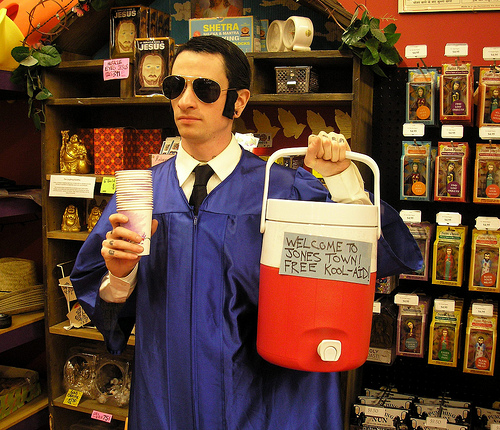
In South Bend, IN, a restaurant removed billboards that referred to the 1978 Jonestown cult mass suicides in which more than 900 people drank cyanide-laced punch. VP of sales & marketing for Hacienda Restaurant, Jeff Leslie, said,“We made a mistake and don’t want to have a negative image in the community.” The billboards included the statement, “We’re like a cult with better Kool-Aid,” over a glass of a drink, with the phrase “To die for!”
✉ Guidelines for submissions: QUICK BYTES publishes only events, special dinners, etc, open to the public, not restaurant openings or personnel changes. When submitting please send the most pertinent info, incl. tel # and site, in one short paragraph as simple e-mail text, WITH DATE LISTED FIRST, as below. Thanks. John Mariani
| From March 21 through 25 in New York City, Barbounia presents Moroccan Spring Market at Barbounia featuring the sights, sounds and flavors inspired by this mystical North African country. The special Moroccan menu is also a spring tribute featuring lighter dishes inspired by the warm weather. Executive Chef Efraim Naon, who has strong Moroccan roots, has prepared a menu of authentic sweet and savory fare that includes recipes passed down to him from his grandmother. For more information and reservations please visit Barbounia.com or call 212.995.0242. |
| On March 22, Lockwood Restaurant in Chicago, IL, will host a Goose Island Beer Dinner. Brewmaster Jim DeBolt will lead guests through a five-course tasting menu prepared by Executive Chef Greg Elliott as expertly matched with a craft beer from the local brewery. $50. Call 312-917-3404 or visit www.lockwoodrestaurant.com. |
| On Mar. 23 in Denver, CO The Ritz-Carlton's signature restaurant, ELWAY'S Downtown will host a Calera Wine Company four-course pairing dinner featuring a seasonal menu by Executive Chef Justin Fields and ELWAY'S Chef Robert Bogart . Attendees will get to meet the winemaker, Josh Jensen. Selected wines include Viognier -Central Coast, 2009, Pinot Noir - Central Coast, 2008, “Ryan Vineyard” Pinot Noir - Mount Harlan, 2007 and “Mills Vineyard” Pinot Noir -Mount Harlan, 2000. $100 pp plus tax and gratuity. Call 303-312-3107 or visit www.elways.com |
|
On Mar. 23, in New York, NY, Alma 33 is
partnering with Dallis Bros. Coffee to present a
coffee pairing dinner, utilizing Dallis’ high-end Octavio Coffee
line. Two courses of Alma 33’s Argentinean-inspired dishes will
be paired with a specially crafted coffee cocktail, while two desserts
will incorporate coffee in them and pair cups of coffee brewed with
different methodologies by Dallis Q grader John Moore.
$40pp. 212-380-8794.
|
|
On
Mar. 23, Gibsons
Bar &
Steakhouse in Oak Brook, IL,
will
host
a
Cambria
Estate
Winery
wine
dinner.
Emily
Oakes will
lead guests through each selection of wine paired with a 5-course menu
by Executive Chef Brian Key. $95pp. Call 630-954-0000 or visit www.gibsonssteakhouse.com. |
| On Mar 24, Farm Burger in Decatur, Ga, Taking the Burger out Farm Burger Spring Supper. A four course + Spring Supper featuring the animals and crops from our Farms and other local farmer friends. Oxtail, chicken hearts, guancale, pork belly, greens, turnips, spring garlic goodness and even a treat from the Ga. Coast and nary a burger insight the whole night. $38pp call 404-378-5077 or www.farmburger.net. |
| On March 31, in Atlanta, RA Sushi is hosting a Maki Madness sushi-eating contest to coincide with NCAA March Madness. The contest is organized into a bracket system and competitors will be eating RA Sushi’s signature Tootsy Maki. The grand prize eater will win sushi for a year. Food and drink specials will be available all day for guests. Deadline to register is March 29, and the contest is limited to first 40 entries. No cost to register. Call 404-267-0114 or visit www.RAsushi.com. |
| On March 31 in Tow, Texas, Fall Creek Vineyards will host the Savor the Hill Country Luncheon, an annual sell-out of the Texas Hill Country Wine & Food Festival. The luncheon will feature three of Texas' top chefs; Josh Watkins of the Carillon Hotel, Kent Rathbun of Abacus and Isaac Cantu of Francesca's at Sunset. Three extraordinary dishes will be paired with wines from three of Texas' leading wineries, Spicewood Vineyards, Llano Estacdo and Fall Creek Vineyards. $65 per person, visit www.texaswineandfood.org to reserve/purchase. |
| Through March 31 in San Francisco, CA, Ozumo will donate 100% of the proceeds of their Kibou No Hana (“flower of hope”) specialty cocktail to Japan tsunami relief efforts. Call (415) 882-1333 or visit www.Ozumo.com |
| On Apr. 1 and 2, Hop Scotch Spring Beer & Scotch Festival in Seattle, WA, features beer, wine, Scotch and tequila tasting at Fremont Studios. $25 pp. Call 206-633-0422 or visit www.hopscotchtasting.com. |
|
On
Apr 5 in NYC, Maestro
Steven Blier continues the spring season of HENRY’s “Sing for Your
Supper.” An
evening of great music provided from New York City’s rising stars of
musical theatre and opera and Chef Mark Barrett’s famous Baked Veal
Ricotta Meatballs featured in the 3-course, Italian-American prix-fixe
dinner. “Sing for Your Supper” will sell out, so please reserve
your table now! Call 212-866-0600 for reservations or visit www.henrysnyc.com. |
|
From
Apr 14-17, Perini
Ranch
Steakhouse in Buffalo Gap,
TX hosts the 7th annual Buffalo Gap Wine and Food Summit –
showcasing Rhone varietals from France, CA, and TX. Guest chefs
Stephan Pyles of Dallas and Jacques Pepin and more. $35 -$500pp. Call
800.367.1721 or visit www.buffalogapsummit.org
|
Any of John Mariani's books below
may be ordered from amazon.com.
" A fact-filled,
entertaining history [that] substantiates its title with hundreds of
facts in this meaty history of the rise of Italian food culture around
the
globe. From Charles Dickens's journey through Italy in 1844 to
20th-century
immigrants to America selling ice cream on the streets of New Orleans,
Mariani
constantly surprises the reader with little-known culinary anecdotes
about
Italy and its people, who have made pasta and pizza household dishes in
the
U.S. and beyond."--Publishers Weekly "Equal
parts
history,
sociology,
gastornomy,
and
just
plain
fun,
How
Italian
Food
Conquered
the
World
tells
the
captivating
and
delicious story of
the (let's face it) everybody's favorite cuisine with clarity, verve
and more than one surprise."--Colman Andrews, editorial director of The Daily Meal.com. "A
fantastic and fascinating read, covering everything from the influence
of Venice's spice trade to the imnpact of Italian immigrants in
America and the evolution of alta cucina. This book will serve as a
terrific resource to anyone iunterested in the real story of Italian
food."--Mary Ann Espositio, hosty of PBS-TV's Ciao Italia. "John
Mariani
has
written
the
definitive
history
of
how
Italians
won
their
way
into
our
hearts,
min
ds,
and
stomachs. It's a story of
pleasure over pomp and taste over technique."--Danny Meyer, owner of
NYC restaurants Union Square Cafe, Gotham Bar & Grill, The Modern,
and Maialino.
|
 |
 |
 |
 |
 |
 |
 |
 |
How to Avoid the 10 Most Annoying Travel Fees

❖❖❖
Eating
Las
Vegas is the new on-line site for Virtual Gourmet
contributor John
A. Curtas., who since 1995 has been commenting on the Las Vegas food
scene and reviewing restaurants for Nevada Public Radio. He is
also
the restaurant critic for KLAS TV, Channel 8 in Las Vegas, and his past
reviews can be accessed at KNPR.org.
Click
on
the
logo
below
to
go
directly
to
his
site.
A Critical Guide to the World's Best Tennis Resorts and Tennis Camps, published by ROGER COX, who has spent more than two decades writing about tennis travel, including a 17-year stretch for Tennis magazine. He has also written for Arthur Frommer's Budget Travel, New York Magazine, Travel & Leisure, Esquire, Money, USTA Magazine, Men's Journal, and The Robb Report. He has authored two books-The World's Best Tennis Vacations (Stephen Greene Press/Viking Penguin, 1990) and The Best Places to Stay in the Rockies (Houghton Mifflin, 1992 & 1994), and the Melbourne (Australia) chapter to the Wall Street Journal Business Guide to Cities of the Pacific Rim (Fodor's Travel Guides, 1991). THIS WEEK: TED HOEHN ADULT CAMP IN VERMONT; NEW ENGLAND TENNIS HOLIDAYS; PEAK TENNIS ACADEMY IN PORTIGAL.

❖❖❖
The Family Travel Forum
A community for those who
"Have Kids, Still Travel" and want to make family vacations more fun,
less work and better value. FTF's travel and parenting features,
including
reviews of tropical and ski resorts, reunion destinations, attractions,
holiday
weekends, family festivals, cruises, and all kinds of vacation ideas
should be
the first port of call for family vacation planners. http://www.familytravelforum.com/index.html
ALL YOU NEED BEFORE YOU GO

nickonwine: An engaging, interactive wine column by Nick Passmore, Artisanal Editor, Four Seasons Magazine; Wine Columnist, BusinessWeek.com; nick@nickonwine.com; www.nickonwine.com.

MARIANI'S VIRTUAL GOURMET NEWSLETTER is published weekly. Editor/Publisher: John Mariani.
Contributing Writers: Christopher
Mariani, Robert Mariani,
John A. Curtas, Edward Brivio, Mort
Hochstein, Suzanne Wright, and
Brian Freedman. Contributing
Photographers: Galina Stepanoff-Dargery, Bobby Pirillo. Technical
Advisor:
Gerry McLoughlin.
❖❖❖
Click
Here to return to John Mariani's Homepage
© copyright John Mariani 2011

